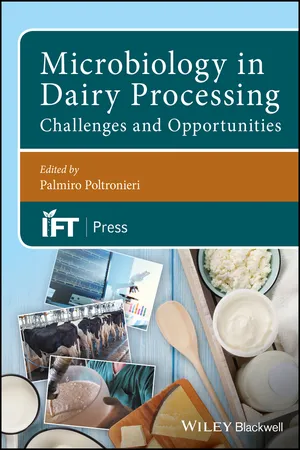
Microbiology in Dairy Processing
Challenges and Opportunities
Palmiro Poltronieri, Palmiro Poltronieri
- English
- ePUB (adapté aux mobiles)
- Disponible sur iOS et Android
Microbiology in Dairy Processing
Challenges and Opportunities
Palmiro Poltronieri, Palmiro Poltronieri
À propos de ce livre
An authoritative guide to microbiological solutions to common challenges encountered in the industrial processing of milk and the production of milk products
Microbiology in Dairy Processing offers a comprehensive introduction to the most current knowledge and research in dairy technologies and lactic acid bacteria (LAB) and dairy associated species in the fermentation of dairy products. The text deals with the industrial processing of milk, the problems solved in the industry, and those still affecting the processes. The authors explore culture methods and species selective growth media, to grow, separate, and characterize LAB and dairy associated species, molecular methods for species identification and strains characterization, Next Generation Sequencing for genome characterization, comparative genomics, phenotyping, and current applications in dairy and non-dairy productions.
In addition, Microbiology in Dairy Processing covers the Lactic Acid Bacteria and dairy associated species (the beneficial microorganisms used in food fermentation processes): culture methods, phenotyping, and proven applications in dairy and non-dairy productions. The text also reviews the potential future exploitation of the culture of novel strains with useful traits such as probiotics, fermentation of sugars, metabolites produced, bacteriocins. This important resource:
- Offers solutions both established and novel to the numerous challenges commonly encountered in the industrial processing of milk and the production of milk products
- Takes a highly practical approach, tackling the problems faced in the workplace by dairy technologists
- Covers the whole chain of dairy processing from milk collection and storage though processing and the production of various cheese types
Written for laboratory technicians and researchers, students learning the protocols for LAB isolation and characterisation, Microbiology in Dairy Processing is the authoritative reference for professionals and students.
Foire aux questions
Informations
1
Milk fat components and milk quality
1.1 INTRODUCTION
1.1.1 Milk fat globules
| Cow | Buffalo | Goat | Sheep | Donkey | Horse | Human | ||
| Fat | % | 3.70 | 8.14 | 3.90 | 6.50 | 0.36 | 1.48 | 3.34 |
| Average diameter of the fat globules | µm | 3.5–5.5 | 2.96–5.0 | 2.2–2.8 | 2.79–4.95 | 2 | 2–3 | 3.3 |
| SFA | g/100g fat | 71.24 | 65.9 | 70.42 | 71.85 | 55.55 | 45.18 | 41.77 |
| MUFA | g/100g fat | 25.56 | 31.4 | 25.67 | 26.04 | 22.21 | 31.88 | 38.73 |
| PUFA | g/100g fat | 3.20 | 2.70 | 4.08 | 2.10 | 21.08 | 22.93 | 16.96 |
| UFA | g/100g fat | 28.76 | 34.1 | ...